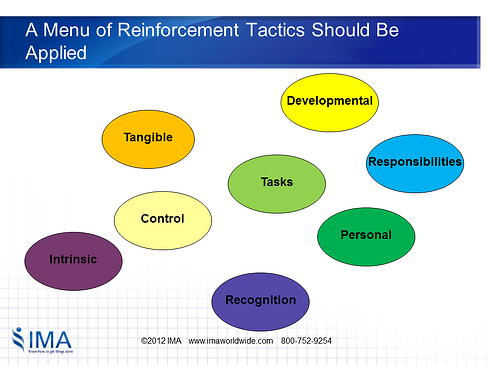Last week, our blog focused on the fact that reinforcement is the golden key to implementation success. We explained that if you want people to change their behavior; you have to alter their reinforcements. It’s a pretty simple concept really and one we don’t think surprised many of you. But now we ask, how exactly do you go about doing that? Why does one reinforcement tactic work for one person, but not another? 
This week, we take a deeper dive into the mechanics of reinforcement and how using the right reinforcements at the right time (in other words the golden key) can be used to unlock the door to implementation success.
Frames of Reference
If we could answer the above questions in just three words they would be…Frame. Of. Reference. Simply put, Frame of Reference is someone’s world-view or perspective. Everyone has a Frame of Reference, and often they have multiple ones. Your Frame of Reference may be based on the business area you work in, your professional affiliation, your position level, or any other group that you are part of.
The key to understanding Frame of Reference is that you must recognize that different individuals have different Frame of References! So, what's "positive" to one person is not necessarily positive for another. This is the reason you will never find a single reinforcement that motivates everyone.
In addition, like individuals, groups can also develop a collective Frame of Reference. On an organizational level, this is called your “culture.” Collective Frames of Reference (and individual Frames of Reference as well) are very difficult to change, and definitely can’t be ignored.
A Menu of Reinforcements
It goes without saying then, that Reinforcement needs to be from the Frame of Reference of the individual. In other words, for any Reinforcement to impact behavior, it must have meaning or value for the individual or group you are trying to motivate {Tweet This}. 
Thus, one of the major contributions that Change Agents can make is to help Reinforcing Sponsors to develop a menu of Reinforcements. In fact, it's one of the most important elements of good Sponsor Contracting. Here’s a list of just a few examples of Reinforcements you can use:
- Assignment of new tasks or duties
- Larger inter-departmental role
- Public recognition
- Relief from unpleasant tasks
- Awards
The one “surgeon general’s warning” is not to assume you know what is meaningful to any individual. The best option- ask!
Targeted Reinforcement Index
The Targeted Reinforcement Index is an AIM tool that can be a great resource to help your Sponsors identify which specific rewards will be meaningful for the Targets of a change. The tool works in a somewhat unusual way—the Target completes the tool and identifies which Reinforcements s/he find meaningful, and the manager does the same. The tool then helps sort Reinforcements into the following 7 categories:
-
Targeted – Currently being used and are valued by the employee
-
Opportunity – Not currently being used, but have significant leverage in motivating the direct report.
-
Unseen Reinforcer – Not consciously being used, but perceived by the employee as being applied.
-
Perception Differences –A difference of opinion between employee and manager whether these Reinforcers are being used or not.
-
No Response – The Manager perceives these to be used, but the employee does not.
-
Resource Waste - Currently being used, but from the Frame of Reference of the employee it has no Reinforcement value
-
Not Applicable –Not offered, recognized or viewed as effective at this time.
After both the manager and direct report have filled out the TRI, the two come together for a discussion comparing results. This provides a great opportunity for identifying what is important for each direct report, rather than playing a guessing game. In addition, getting input like this from employees is a great involvement technique.
In our 30+ years doing change management consulting work, we, frankly, have been quite surprised by some of the results of TRI assessments. In one organization, the most significant Reinforcement was the opportunity to select some logo merchandise! In another, it was having photos of the best performers displayed on the walls of the company headquarters! Whatever works has always been our motto!
Reinforcements can be just about anything and as long as they are meaningful from the frame of reference of the target. Once you determine exactly what is meaningful and what is not you will be ready to apply the right Reinforcement- and see the value of the golden key to implementation success.


